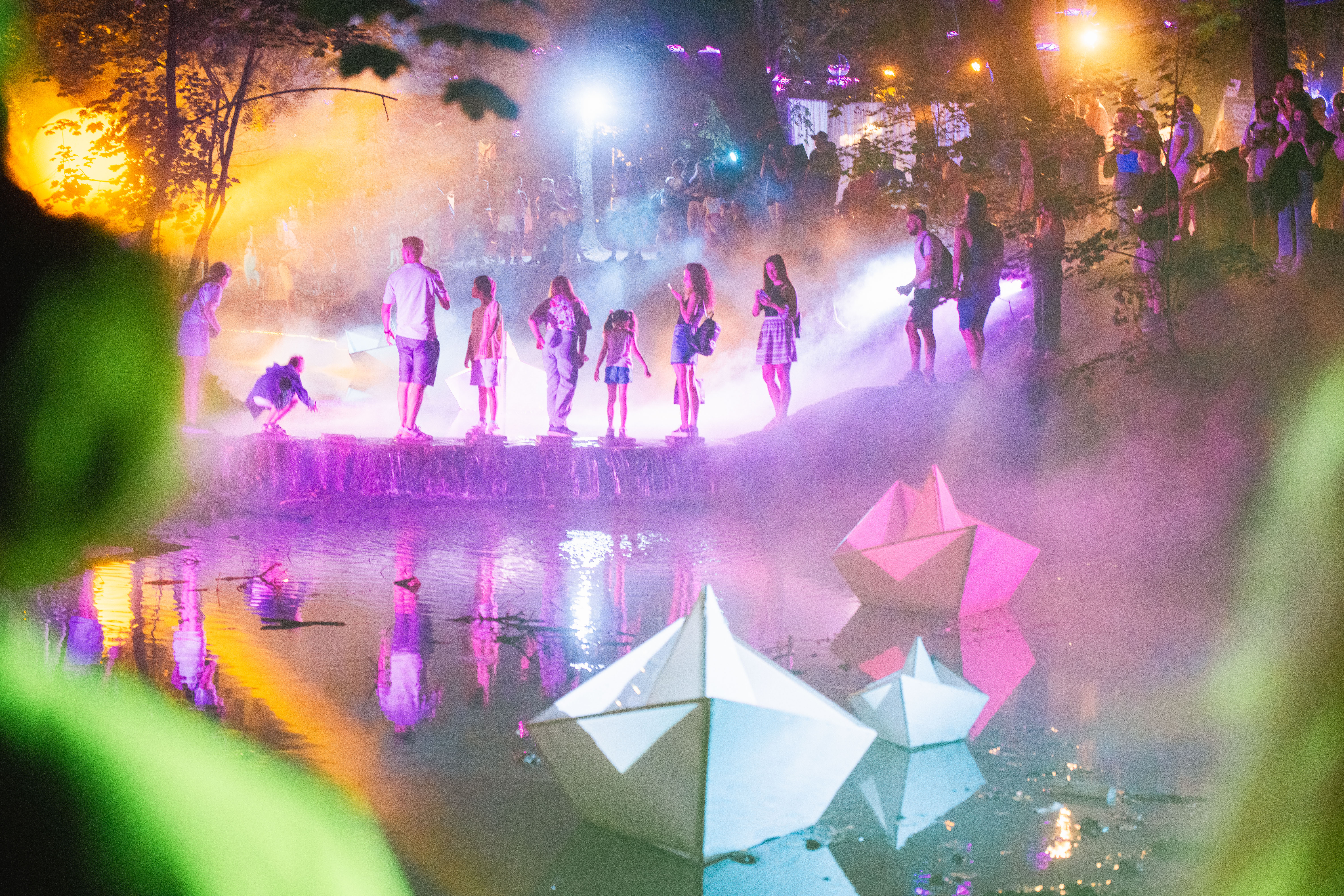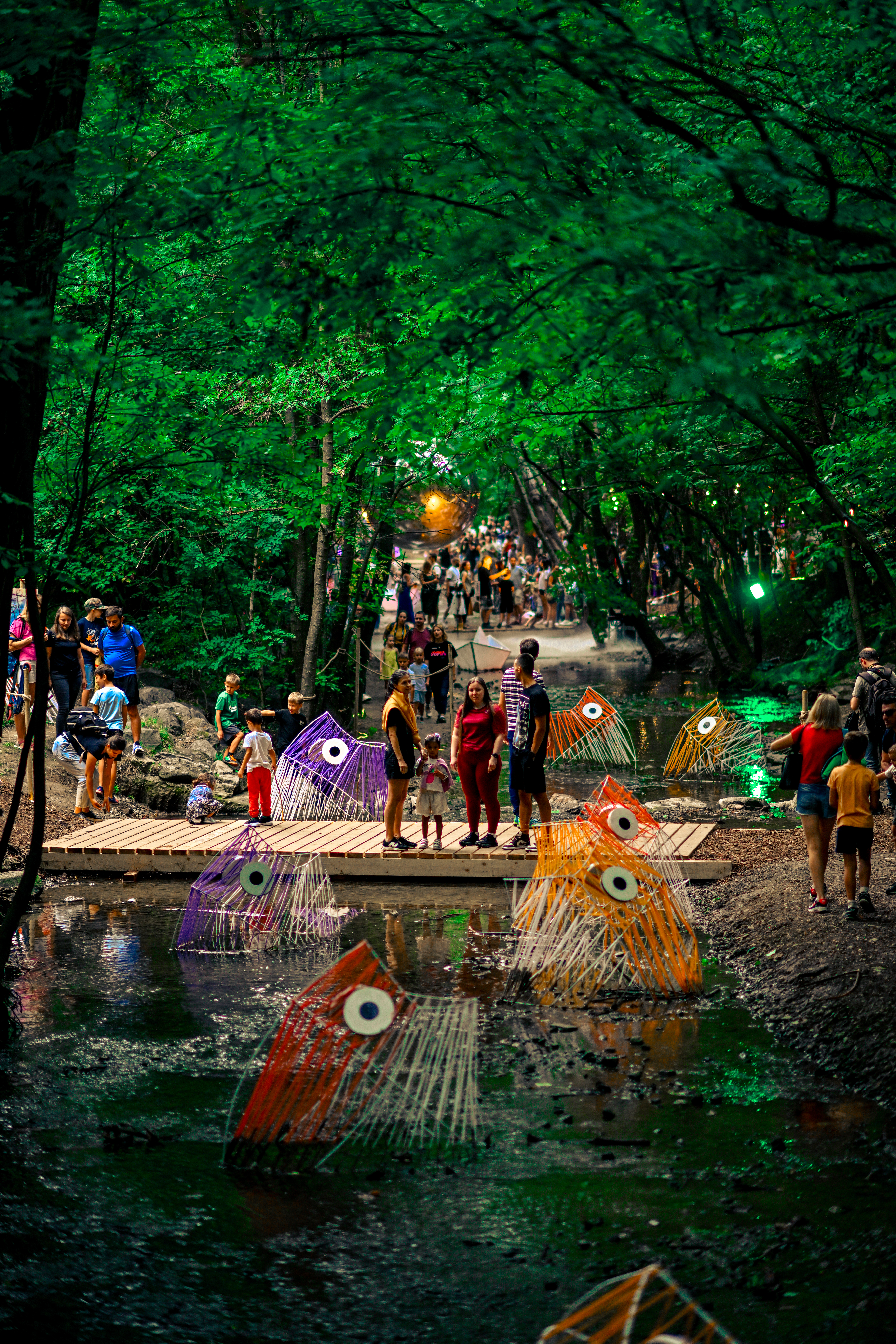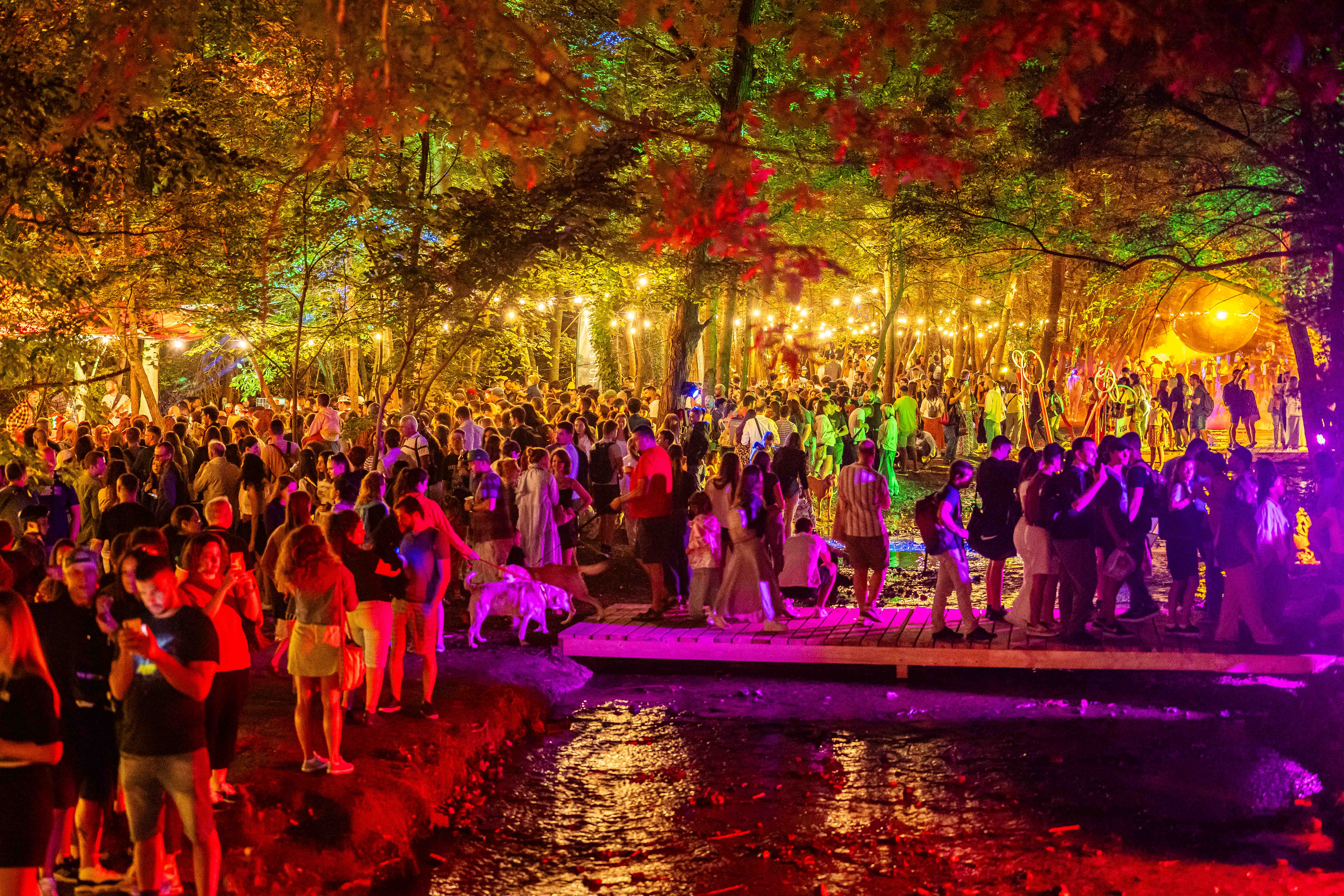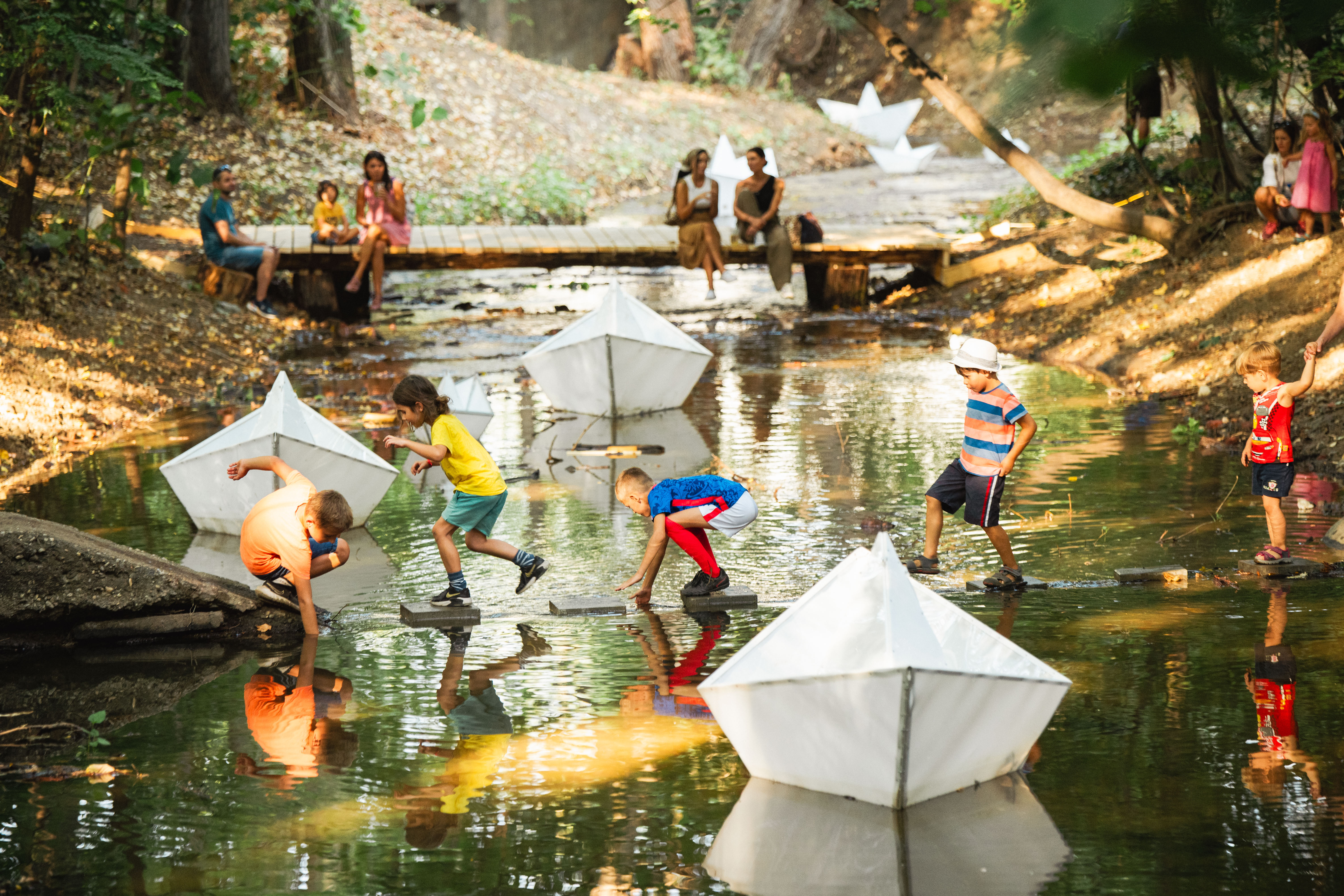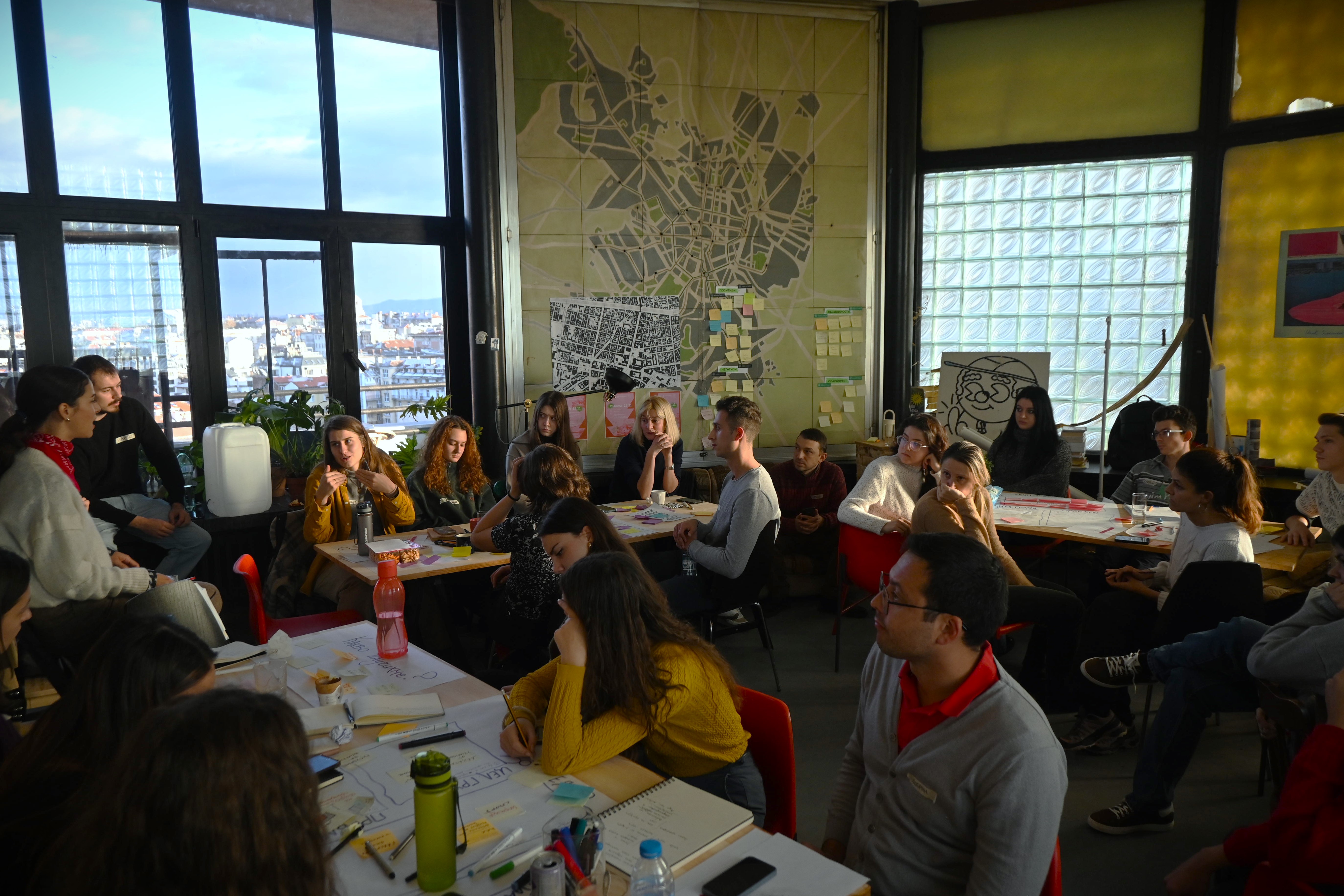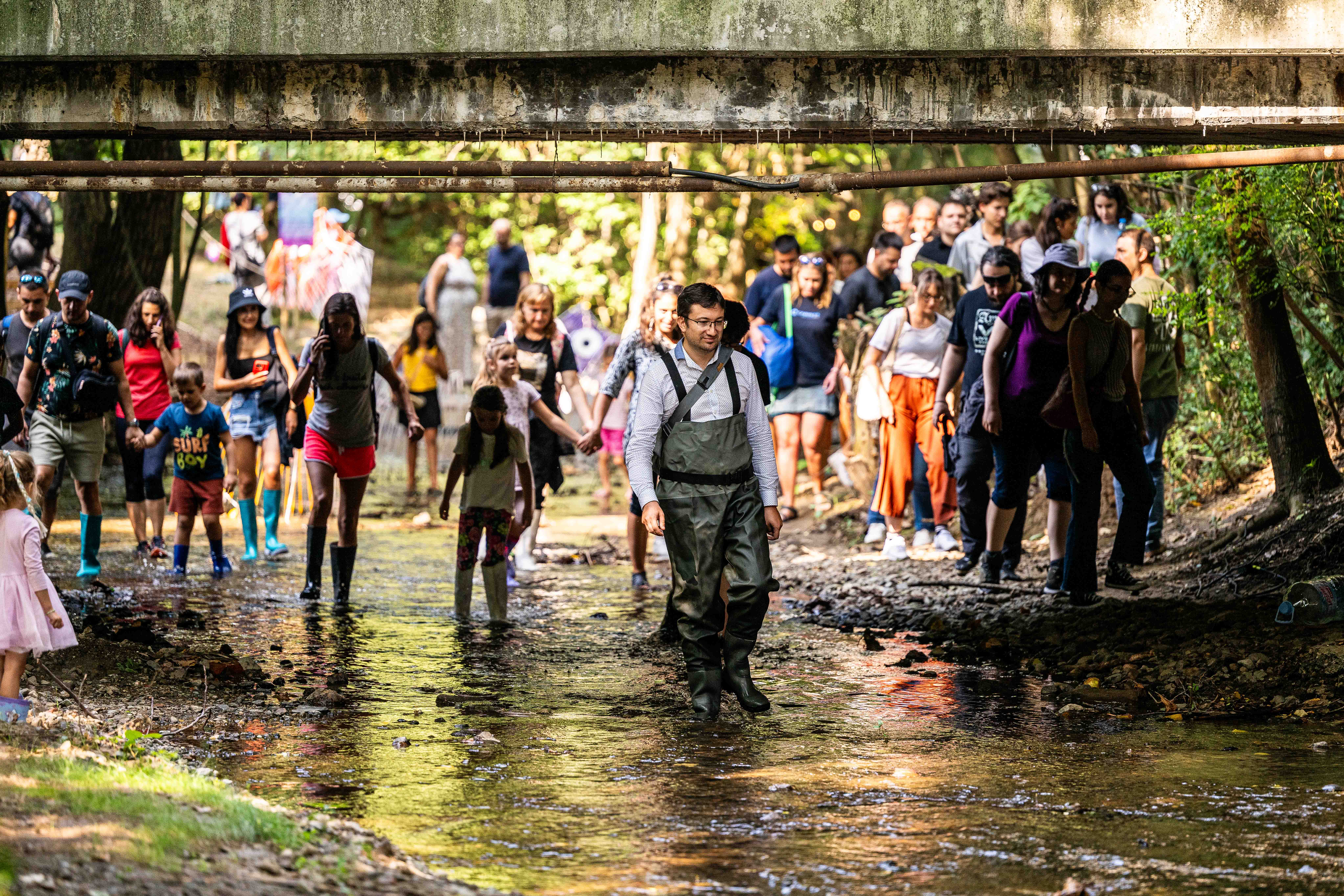Reconnecting with nature
Perlovska Project
Action for Urban River Adaptation
The Perlovska Project introduces a dynamic, community-led strategy to revitalise Sofia’s neglected rivers. Integrating placemaking, expert-led strategies, on-the-ground research and festivals, the project builds lasting momentum for large-scale urban transformation. A dedicated communication and advocacy plan, reinforced by media partnerships and public outreach, drives institutional involvement, amplifying the inititive’s impact and reshaping the city’s rivers as vital green-blue arteries.
Bulgaria
Local
Sofia, Bulgaria
Mainly urban
It refers to a physical transformation of the built environment (hard investment)
Yes
2024-12-19
No
No
No
As a representative of an organisation
Sofia is home to over 30 rivers, neglected, polluted and forgotten for decades. Despite their ecological and cultural potential, they have been reduced to mere infrastructural afterthoughts. The Perlovska Project has transformed the narrative through strategic placemaking, workshops, cultural events, and an extensive communication campaign, compelling the city's administration to prioritize river development in its urban planning strategies. This, combined with a cleanup of more than 120 sewage overflows in 2024, has set Sofia’s river revitalization into a continuous motion.
At its core the project is built upon two fundamental principles: unity and action. It takes a bold, interdisciplinary approach, using art and architecture to create a vibrant platform where ecologists, urbanists, water engineers, activists, and policymakers meet and work together to unlock the untapped potential of Sofia’s rivers.
The project uses an on-the-ground approach, working step by step to revitalize the riverbanks, gradually transforming abandoned waterways into lively public landscapes through community based placemaking. The initiative also harnesses the power of cultural events to expand its reach, engaging wider audiences through public art competitions, installations, short films, music, and exhibitions that spotlight the problems and the potential of urban rivers.
The impact of the Perlovska Project is evident as Sofia municipality is now responding and implementing new policies and actions that reinforce our shared vision for Sofia’s rivers. Simultaneously, the Perlovska Project team and its network of experts are developing a comprehensive database and large-scale transformation strategies, while actively engaging the wider community in the process.
This replicable model for urban river restoration extends beyond Sofia, inspiring local groups and municipalities in other bulgarian cities to take river action, proving that rivers can once again be the cradle of urban life.
At its core the project is built upon two fundamental principles: unity and action. It takes a bold, interdisciplinary approach, using art and architecture to create a vibrant platform where ecologists, urbanists, water engineers, activists, and policymakers meet and work together to unlock the untapped potential of Sofia’s rivers.
The project uses an on-the-ground approach, working step by step to revitalize the riverbanks, gradually transforming abandoned waterways into lively public landscapes through community based placemaking. The initiative also harnesses the power of cultural events to expand its reach, engaging wider audiences through public art competitions, installations, short films, music, and exhibitions that spotlight the problems and the potential of urban rivers.
The impact of the Perlovska Project is evident as Sofia municipality is now responding and implementing new policies and actions that reinforce our shared vision for Sofia’s rivers. Simultaneously, the Perlovska Project team and its network of experts are developing a comprehensive database and large-scale transformation strategies, while actively engaging the wider community in the process.
This replicable model for urban river restoration extends beyond Sofia, inspiring local groups and municipalities in other bulgarian cities to take river action, proving that rivers can once again be the cradle of urban life.
Rivers
Urbanism
Network
Advocacy
Action
Over the past two years, the Perlovska Project has revitalised over 500 meters of riverbank at 2 key locations along the Perlovska River. More than 2 tons of domestic waste were removed from the river. Waters and banks. Additionally, with the help of the awareness raising campaign of the project and its wide network of partners 122 sewage overflow points were cleared, reducing the influx of domestic wastewater into multiple Sofia rivers. A dental urban section of the riverbed was cleared of fallen trees and the reclaimed timber was repurposed into seating, interactive sculptures, insect “hotels” and mulching. Pathways were also created, using mulch to facilitate easy access to the river, creating welcoming open spaces for recreation. These transformations were celebrated with 2 festivals held at the revitalised locations, highlighting the project's success to increase awareness, leading to more public credibility and sustainability of the initiative.
Both events were designed to have a light environmental footprint, featuring easily removable and reusable structures, such as temporary wooden bridges, and pavilions made of wooden beams and fabric. Hay bales served dual purposes as rustic seating and interactive installations for play. These designs demonstrate how simple, cost-effective solutions can sustainably transform spaces without heavily impacting the environment.
The project also embraced sustainability in a broader sense - on the societal and policy level. Following two impactful conferences on the future of the Perlovska River, where we presented original research findings, leading to a memorandum for sustainable river management which was signed by the Mayor of Sofia, 4 district mayors, and several key non-profit organisations. The signatories have committed to executing the outlined priorities, assuring further sustainability of the initiative.
Both events were designed to have a light environmental footprint, featuring easily removable and reusable structures, such as temporary wooden bridges, and pavilions made of wooden beams and fabric. Hay bales served dual purposes as rustic seating and interactive installations for play. These designs demonstrate how simple, cost-effective solutions can sustainably transform spaces without heavily impacting the environment.
The project also embraced sustainability in a broader sense - on the societal and policy level. Following two impactful conferences on the future of the Perlovska River, where we presented original research findings, leading to a memorandum for sustainable river management which was signed by the Mayor of Sofia, 4 district mayors, and several key non-profit organisations. The signatories have committed to executing the outlined priorities, assuring further sustainability of the initiative.
The project harnesses art, culture, and architecture to communicate the significance of rivers to a broad audience through year-round campaigns.The project team conducted an international visual art competition titled "Rivers of the Future" to enhance engagement and awareness. Over 150 artists submitted visual works envisioning the future development of urban river spaces. This competition, including public voting, reached over 400,000 people via a communication campaign. We successfully used visual art to engage and inform a broad public about the ecological risks and opportunities linked to urban rivers.
To maximise the project’s impact, the team partnered with a creative video production studio to effectively communicate details about the Perlovska River, including new research findings, to a wide audience. This collaboration resulted in a 20-minute documentary featuring interviews with experts and municipal workers. The film provides a clear presentation of the challenges facing Sofia’s rivers and proposes viable solutions, making the information accessible for all city residents.
The project's highlights included 2 festivals, which were designed to unlock the river's cultural and social potential. Both events were hosted in urban spaces where the river was not publicaly accessible or used. During the festivals, tents, pavilions, and stages were strategically designed and placed to attract people to the river. Repurposed parachutes acted as dynamic decoration that also provided shade. Art installations revealed the site’s natural beauty. The festivals’ visual appeal attracted record numbers of visitors, with around 60,000 people coming to experience and celebrate Perlovska River in 2024. A new aesthetic turned previously unused and inaccessible spaces into some of the most popular sites in the capital. This shows the impact design can have as a community-building and advocacy tool in urban transformation.
To maximise the project’s impact, the team partnered with a creative video production studio to effectively communicate details about the Perlovska River, including new research findings, to a wide audience. This collaboration resulted in a 20-minute documentary featuring interviews with experts and municipal workers. The film provides a clear presentation of the challenges facing Sofia’s rivers and proposes viable solutions, making the information accessible for all city residents.
The project's highlights included 2 festivals, which were designed to unlock the river's cultural and social potential. Both events were hosted in urban spaces where the river was not publicaly accessible or used. During the festivals, tents, pavilions, and stages were strategically designed and placed to attract people to the river. Repurposed parachutes acted as dynamic decoration that also provided shade. Art installations revealed the site’s natural beauty. The festivals’ visual appeal attracted record numbers of visitors, with around 60,000 people coming to experience and celebrate Perlovska River in 2024. A new aesthetic turned previously unused and inaccessible spaces into some of the most popular sites in the capital. This shows the impact design can have as a community-building and advocacy tool in urban transformation.
The project was designed with inclusivity at its core, employing a variety of approaches- film, art competitions, workshops, conferences, cleanup initiatives, and festivals—to engage the broadest possible audience. All events are always free and open to everyone. The project has been successful in engaging different communities, from urban experts and municipal leaders to local artists, civic society groups, and varied mass audiences. The festivals were particularly impactful, attracting over 90,000 visitors across 2 editions. The layout was designed to include areas for both active engagement and relaxation, catering to varying ages, interests, and neurodiversity, thus ensuring inclusive participation.
A wide array of activities was created to appeal to different demographics, including sports and children’s activities, while embedding the river theme throughout the cultural programming of the events. The placemaking designs that activated the riverside areas, as well as the project’s longer-term plans for the rivers, are fundamentally a collaborative effort. These plans are created by working groups uniting professionals from different fields, including civil engineering, design, and ecology. They worked together to draft proposals for the rivers as integral parts of the city, which were later prioritised in Sofia Municipality’s funding initiatives.
Local residents were involved in cleanup campaigns and the construction of urban furniture, bird houses and a free library, fostering a collective sense of placemaking. This approach not only enhanced the sense of public ownership but also helped shift public perceptions of the rivers. The tens of thousands of visitors developed a new appreciation for urban nature in Sofia, recognising its value not just as a utility but as a source of beauty, wellbeing, and community. This project stands as an example of how embedding inclusivity at different stages can profoundly reshape interactions with urban environments.
A wide array of activities was created to appeal to different demographics, including sports and children’s activities, while embedding the river theme throughout the cultural programming of the events. The placemaking designs that activated the riverside areas, as well as the project’s longer-term plans for the rivers, are fundamentally a collaborative effort. These plans are created by working groups uniting professionals from different fields, including civil engineering, design, and ecology. They worked together to draft proposals for the rivers as integral parts of the city, which were later prioritised in Sofia Municipality’s funding initiatives.
Local residents were involved in cleanup campaigns and the construction of urban furniture, bird houses and a free library, fostering a collective sense of placemaking. This approach not only enhanced the sense of public ownership but also helped shift public perceptions of the rivers. The tens of thousands of visitors developed a new appreciation for urban nature in Sofia, recognising its value not just as a utility but as a source of beauty, wellbeing, and community. This project stands as an example of how embedding inclusivity at different stages can profoundly reshape interactions with urban environments.
Perlovska Project involves a wide community in experiencing the crucial role rivers play in urban environments. Through pilot site landscape transformations, the project demonstrates what revitalised rivers can contribute to the city. The project also encourages public involvement through volunteering in river clean-up campaigns and on site participation in the creation of urban furniture, access stairs, bridges, and decoration. This hands-on involvement allows them to directly experience and be part of the river transformation.
The vast public engagement and support had a significant impact on the project, as a powerful advocacy tool to drive policy change. City administrators and government officials have noted the strong public demand for river revitalisation. The public enthusiasm has led to enhanced cooperation among various governmental bodies, taking part in structured dialogues through roundtables and conferences, organised by our team. These discussions have included key stakeholders such as external experts, citizens and representatives of civil society organisations, officials from the Ministry of Environment and Water, district mayors, and leaders from Veolia/ Sofia Water (a private company operating Sofia’s water infrastructure).
Outcomes were highlighted in two open conferences. The first, aligned with the project’s second festival, utilised the large gathering to engage even more public feedback. A subsequent conference presented a detailed action plan to the mayor and key stakeholders, resulting in the signing of a memorandum for sustainable river management.
This approach has proven that collective effort, on-the-ground work and public will can significantly influence municipal priorities, leading to more responsive and community-focused urban development.
The vast public engagement and support had a significant impact on the project, as a powerful advocacy tool to drive policy change. City administrators and government officials have noted the strong public demand for river revitalisation. The public enthusiasm has led to enhanced cooperation among various governmental bodies, taking part in structured dialogues through roundtables and conferences, organised by our team. These discussions have included key stakeholders such as external experts, citizens and representatives of civil society organisations, officials from the Ministry of Environment and Water, district mayors, and leaders from Veolia/ Sofia Water (a private company operating Sofia’s water infrastructure).
Outcomes were highlighted in two open conferences. The first, aligned with the project’s second festival, utilised the large gathering to engage even more public feedback. A subsequent conference presented a detailed action plan to the mayor and key stakeholders, resulting in the signing of a memorandum for sustainable river management.
This approach has proven that collective effort, on-the-ground work and public will can significantly influence municipal priorities, leading to more responsive and community-focused urban development.
The project engaged over 30 diverse partners including cultural and civic organizations, local businesses, and expert groups. They contributed expertise to develop action plans and databases, supported educational efforts, donated materials, engaged wider public and helped enhance cultural programming.
Key partners in data collection and management – the initiative “One Tree” – undertook extensive field research to map the Perlovska River. This was critical because the river had never been accurately mapped in Sofia’s cadastre, leading to risks of unregulated construction and urban development directly affecting the Perlovska River’s tributaries.They documented ecological parameters, such as flow rate, water temperature, and biodiversity, as well as any obstructions or illegal constructions. This thorough data collection provided the basis for an accurate and updated river map, which allows further green urban development.
The University of Architecture and Urban Planning in Sofia supported the project by integrating case studies about Sofia’s rivers into their curriculum. Students developed semester projects focused on riverside design, which were later showcased at one of the festivals, further integrating academic insights with community initiatives.
Private businesses supported the initiative through donations and awareness campaigns. “Visa” and “dm Bulgaria” launched online campaigns to highlight the importance of rivers. “Dm” leveraged its network of shops throughout the country to promote the initiative, and to recruit volunteers for river cleanups.
The Municipality was crucial in supporting not only cleanup operations and festival logistics, but played a key role by endorsing the initiative through a memorandum that prioritized rivers in the city's green strategies.
This extensive network of stakeholders, ranging from local mayors, universities, businesses to artists significantly enhanced the impact of the initiative.
Key partners in data collection and management – the initiative “One Tree” – undertook extensive field research to map the Perlovska River. This was critical because the river had never been accurately mapped in Sofia’s cadastre, leading to risks of unregulated construction and urban development directly affecting the Perlovska River’s tributaries.They documented ecological parameters, such as flow rate, water temperature, and biodiversity, as well as any obstructions or illegal constructions. This thorough data collection provided the basis for an accurate and updated river map, which allows further green urban development.
The University of Architecture and Urban Planning in Sofia supported the project by integrating case studies about Sofia’s rivers into their curriculum. Students developed semester projects focused on riverside design, which were later showcased at one of the festivals, further integrating academic insights with community initiatives.
Private businesses supported the initiative through donations and awareness campaigns. “Visa” and “dm Bulgaria” launched online campaigns to highlight the importance of rivers. “Dm” leveraged its network of shops throughout the country to promote the initiative, and to recruit volunteers for river cleanups.
The Municipality was crucial in supporting not only cleanup operations and festival logistics, but played a key role by endorsing the initiative through a memorandum that prioritized rivers in the city's green strategies.
This extensive network of stakeholders, ranging from local mayors, universities, businesses to artists significantly enhanced the impact of the initiative.
The Perlovska Project brought together experts from environmental science, urban planning, architecture, and culture and the arts. This diverse team was essential for addressing the complex issues of river conservation and urban redevelopment.
Environmental Science and Ecology: Specialists conducted detailed field research to map the Perlovska River and assess its ecology. They developed a cost-effective GIS mobile platform for collecting data on riverbeds and their features. This platform enables users to mark exact locations and add photos using only a mobile device with internet access, creating a comprehensive profile of the riverbed's condition, challenges, and opportunities.
Architecture and design: Architects and landscape architects worked together to create designs that made the river areas accessible, beautiful, and ecologically sustainable. Their projects included pathways and installations that were carefully planned to avoid harming the local ecosystem while making the river easier to reach and more visually appealing.
Art and culture: Artists, performers, and cultural managers applied their expertise to create a total festival experience that led tens of thousands of people to see the wild sections of Perlovska River in a new light. Their contributions, including site-specific installations, performances, and an international visual arts contest, transformed neglected riversides into vibrant cultural hubs.
Experts from these fields worked together in a space managed by The Collective Foundation – the Incubator for Urban Development. Their meetings became a forum to debate different approaches, distribute tasks, and track progress. This multidisciplinary approach allowed us to meaningfully shift the role of rivers in governance, urban infrastructure, and the popular imagination. Rivers are now recognised by various audiences and stakeholders as cultural and ecological assets, and as key public spaces essential for a city's inclusive development.
Environmental Science and Ecology: Specialists conducted detailed field research to map the Perlovska River and assess its ecology. They developed a cost-effective GIS mobile platform for collecting data on riverbeds and their features. This platform enables users to mark exact locations and add photos using only a mobile device with internet access, creating a comprehensive profile of the riverbed's condition, challenges, and opportunities.
Architecture and design: Architects and landscape architects worked together to create designs that made the river areas accessible, beautiful, and ecologically sustainable. Their projects included pathways and installations that were carefully planned to avoid harming the local ecosystem while making the river easier to reach and more visually appealing.
Art and culture: Artists, performers, and cultural managers applied their expertise to create a total festival experience that led tens of thousands of people to see the wild sections of Perlovska River in a new light. Their contributions, including site-specific installations, performances, and an international visual arts contest, transformed neglected riversides into vibrant cultural hubs.
Experts from these fields worked together in a space managed by The Collective Foundation – the Incubator for Urban Development. Their meetings became a forum to debate different approaches, distribute tasks, and track progress. This multidisciplinary approach allowed us to meaningfully shift the role of rivers in governance, urban infrastructure, and the popular imagination. Rivers are now recognised by various audiences and stakeholders as cultural and ecological assets, and as key public spaces essential for a city's inclusive development.
The project was innovative for operating simultaneously on multiple scales – applying hyperlocal interventions tailored to specific sites in Sofia, alongside a broader national campaign to improve urban rivers and cooperation with higher-level stakeholders from policy, business, and academia. The project is also innovative for its direct use of art and design to drive community building as well as policy change.
The two festivals along Perlovska river attracted over 90,000 visitors and transformed large neglected areas into vibrant hubs for culture, nature, and community engagement. The placemaking transformations also act as a proof of concept, showing how otherwise disused riverbank areas can function long-term. In 2024, an international art competition calling for visions of positive futures for rivers further served to attract broad audiences and to demonstrate to stakeholders and decision-makers what is possible.
The initiative combines these grassroots efforts and artistic projects with expert working groups conducting research and developing policy proposals, as well as direct advocacy. With this powerful interdisciplinary approach, we were able to catalyze policy changes. Thus, the project is at the forefront of collective placemaking, public art, and green urbanism.
Unlike projects that may focus on one or a few aspects of urban transformation: community building, arts, ecological preservation, urban planning, research, or advocacy, Perlovska Project finds ways to effectively integrate all of these so that different inputs from various stakeholders contribute to the overall goal and create short and longer-term change. The project is a meaningful example for actors in other cities of how, even with low budgets, multi-level coalitions with a shared vision for urban rivers can have an outstanding impact on specific sites, as well as urban management and policy.
The two festivals along Perlovska river attracted over 90,000 visitors and transformed large neglected areas into vibrant hubs for culture, nature, and community engagement. The placemaking transformations also act as a proof of concept, showing how otherwise disused riverbank areas can function long-term. In 2024, an international art competition calling for visions of positive futures for rivers further served to attract broad audiences and to demonstrate to stakeholders and decision-makers what is possible.
The initiative combines these grassroots efforts and artistic projects with expert working groups conducting research and developing policy proposals, as well as direct advocacy. With this powerful interdisciplinary approach, we were able to catalyze policy changes. Thus, the project is at the forefront of collective placemaking, public art, and green urbanism.
Unlike projects that may focus on one or a few aspects of urban transformation: community building, arts, ecological preservation, urban planning, research, or advocacy, Perlovska Project finds ways to effectively integrate all of these so that different inputs from various stakeholders contribute to the overall goal and create short and longer-term change. The project is a meaningful example for actors in other cities of how, even with low budgets, multi-level coalitions with a shared vision for urban rivers can have an outstanding impact on specific sites, as well as urban management and policy.
The Perlovska Project employs a comprehensive methodology to transform urban rivers from polluted and underutilized areas into vibrant community and nature hubs:
Research and Data Collection: Field research utilized a GIS mobile platform for mapping the Perlovska River and assessing its ecological state, accessible to experts and the community. This data helped identify policy gaps and informed proposals for enhanced river management.
Urban Planning: Urban planners and architects pinpointed riverside areas for intervention, creating public spaces that improve river access and integrate it into the cityscape. These areas now facilitate activities like walking, relaxation, and social gatherings.
Art and Culture: Artistic and cultural activities played a crucial role in educating and engaging the public. The project included festivals and cultural events at river locations, with installations and performances that showcased the river's cultural significance.
Community Engagement: The project involved the community in direct actions such as river clean-ups and building urban furniture, boosting local ownership and stewardship.
Institutional Engagement: Collaboration with policymakers was key to promoting effective river management. Roundtables and conferences with stakeholders, including government and environmental experts, fostered discussions on sustainable river strategies.
This multi-faceted approach not only revitalized the Perlovska River but also reshaped community and stakeholder relationships with urban waterways, highlighting their value as environmental and social assets. The methodologies applied here are scalable and aim to be adapted to rejuvenate other rivers across Sofia, making the Perlovska Project a model for sustainable urban river restoration.
Research and Data Collection: Field research utilized a GIS mobile platform for mapping the Perlovska River and assessing its ecological state, accessible to experts and the community. This data helped identify policy gaps and informed proposals for enhanced river management.
Urban Planning: Urban planners and architects pinpointed riverside areas for intervention, creating public spaces that improve river access and integrate it into the cityscape. These areas now facilitate activities like walking, relaxation, and social gatherings.
Art and Culture: Artistic and cultural activities played a crucial role in educating and engaging the public. The project included festivals and cultural events at river locations, with installations and performances that showcased the river's cultural significance.
Community Engagement: The project involved the community in direct actions such as river clean-ups and building urban furniture, boosting local ownership and stewardship.
Institutional Engagement: Collaboration with policymakers was key to promoting effective river management. Roundtables and conferences with stakeholders, including government and environmental experts, fostered discussions on sustainable river strategies.
This multi-faceted approach not only revitalized the Perlovska River but also reshaped community and stakeholder relationships with urban waterways, highlighting their value as environmental and social assets. The methodologies applied here are scalable and aim to be adapted to rejuvenate other rivers across Sofia, making the Perlovska Project a model for sustainable urban river restoration.
Perlovska Project has proven to be a highly replicable model for revitalising urban rivers, sparking similar initiatives across 5 other Bulgarian cities. This model uniquely combines co-design, advocacy, and culture to effectively reconnect cities with their rivers.
The project develops an innovative GIS mobile platform for mapping riverbeds, versatile enough for nationwide use in facilitating data collection. The methodology involves data acquisition, followed by workshops with artists, experts, and policymakers, whose feedback shapes tailored urban interventions. Community volunteers undertake cleaning and landscaping, while a cultural program revitalizes spaces, strengthening community bonds and enhancing the cultural and social value of riverbanks.
Key steps of this multilayered method blending research, collaborative design, arts, creative communications and advocacy have already been successfully transferred to the cities Ruse, Gabrovo, Veliko Tarnovo, Stara Zagora, and Troyan, where ongoing efforts in river cleaning and placemaking are transforming river landscapes and uniting various stakeholders.
The Perlovska Project commits to multi-level engagement, involving local residents, civil society, businesses, creatives, and government. It uses targeted local interventions to build broad coalitions and drive change. Tested out in Bulgaria, this methodology is adaptable and scalable, making it suitable for any European river city or beyond, offering a comprehensive blueprint for urban river restoration through community revitalisation.
The project develops an innovative GIS mobile platform for mapping riverbeds, versatile enough for nationwide use in facilitating data collection. The methodology involves data acquisition, followed by workshops with artists, experts, and policymakers, whose feedback shapes tailored urban interventions. Community volunteers undertake cleaning and landscaping, while a cultural program revitalizes spaces, strengthening community bonds and enhancing the cultural and social value of riverbanks.
Key steps of this multilayered method blending research, collaborative design, arts, creative communications and advocacy have already been successfully transferred to the cities Ruse, Gabrovo, Veliko Tarnovo, Stara Zagora, and Troyan, where ongoing efforts in river cleaning and placemaking are transforming river landscapes and uniting various stakeholders.
The Perlovska Project commits to multi-level engagement, involving local residents, civil society, businesses, creatives, and government. It uses targeted local interventions to build broad coalitions and drive change. Tested out in Bulgaria, this methodology is adaptable and scalable, making it suitable for any European river city or beyond, offering a comprehensive blueprint for urban river restoration through community revitalisation.
Over the past 20 years, cities globally have become the primary habitat for humans, but rapid urbanization has led to massive environmental degradation, especially around urban rivers. These waterways often suffer from overdevelopment, sewage pollution, mismanagement, and biodiversity loss, reducing urban public space quality and access to nature. The Perlovska River model tackles these issues by implementing scalable solutions that can be applied both locally and globally.
By combining strategic partnerships, small-scale artistic and landscape interventions, and media engagement, the project creates a lasting momentum for urban change. This low-cost, high-impact approach works best when applied continuously, like a pulse. The project provides a toolbox for advocacy, for engaging communities, experts, and local authorities to drive large-scale urban transformation.
Another key challenge the project addresses is the urban social disconnection, often caused by the fast paced urban life and the lack of quality public spaces for people to connect and socialise. This weakens the social fabric, often creating fragmented urban communities. The initiative reconnects people with each other and with nature through participatory activities, educational programs, and cultural events. These experiences foster local identity and sense of belonging, engaging large numbers of residents through hands-on involvement.
Tackling complex urban environmental issues requires strong governance and policy frameworks, yet many cities struggle with slow and fragmented administration. The project facilitates roundtables and advocacy efforts, improving communication and coordination between stakeholders. By demonstrating how civic initiatives and expert collaboration can support public institutions, Perlovska Project streamlines operations and influences urban policies, creating a scalable model for other large-scale, community-led urban transformations.
By combining strategic partnerships, small-scale artistic and landscape interventions, and media engagement, the project creates a lasting momentum for urban change. This low-cost, high-impact approach works best when applied continuously, like a pulse. The project provides a toolbox for advocacy, for engaging communities, experts, and local authorities to drive large-scale urban transformation.
Another key challenge the project addresses is the urban social disconnection, often caused by the fast paced urban life and the lack of quality public spaces for people to connect and socialise. This weakens the social fabric, often creating fragmented urban communities. The initiative reconnects people with each other and with nature through participatory activities, educational programs, and cultural events. These experiences foster local identity and sense of belonging, engaging large numbers of residents through hands-on involvement.
Tackling complex urban environmental issues requires strong governance and policy frameworks, yet many cities struggle with slow and fragmented administration. The project facilitates roundtables and advocacy efforts, improving communication and coordination between stakeholders. By demonstrating how civic initiatives and expert collaboration can support public institutions, Perlovska Project streamlines operations and influences urban policies, creating a scalable model for other large-scale, community-led urban transformations.
The project successfully cleaned over 2 kilometers and revitalized 500 linear meters of Perlovska River’s banks, making them accessible to Sofia’s residents. During the first festival in 2023, through a place-making initiative we created Sofia’s first permanent river park. Additionally, public pressure from the initiative and its network led to the cleanup of 120 sewage overflow points in 2024, improving water conditions across multiple city rivers. Community cleanups of Perlovska also removed over 2.5 tonnes of mixed waste.
The initiative reached over 2 million people through festivals, educational campaigns, and media coverage. This widespread engagement not only raised awareness but elevated Perlovska pilot campaign into a national level.
A multidisciplinary network of more than 50 architects, urban planners, engineers, ecologists, artists, researchers, private companies, and public sector leaders united through the project, contributing to a comprehensive river development strategy for Sofia.
Key long-term goals of this strategy include:
- Establishment of a "Waters" unit within Sofia Municipality
- Development of a masterplan for Perlovska River
- Implementation of innovative river monitoring technology
- Elimination of illegal discharges
- Improvement of the river’s management legal framework
Two high-impact conferences on Perlovska river’s future, combined with festivals and cleanup efforts, led to a memorandum for sustainable river management signed by the Mayor of Sofia, four district mayors, and multiple NGO and administrative representatives. This agreement serves as a framework for action, with signatories committing to its outlined priorities.
The Perlovska Project became the spark for a nationwide change. Our comprehensive model has inspired administration and community groups among 5 other cities in Bulgaria to start placemaking initiatives and events, focusing on the improvement of the connection between their rivers and cities.
The initiative reached over 2 million people through festivals, educational campaigns, and media coverage. This widespread engagement not only raised awareness but elevated Perlovska pilot campaign into a national level.
A multidisciplinary network of more than 50 architects, urban planners, engineers, ecologists, artists, researchers, private companies, and public sector leaders united through the project, contributing to a comprehensive river development strategy for Sofia.
Key long-term goals of this strategy include:
- Establishment of a "Waters" unit within Sofia Municipality
- Development of a masterplan for Perlovska River
- Implementation of innovative river monitoring technology
- Elimination of illegal discharges
- Improvement of the river’s management legal framework
Two high-impact conferences on Perlovska river’s future, combined with festivals and cleanup efforts, led to a memorandum for sustainable river management signed by the Mayor of Sofia, four district mayors, and multiple NGO and administrative representatives. This agreement serves as a framework for action, with signatories committing to its outlined priorities.
The Perlovska Project became the spark for a nationwide change. Our comprehensive model has inspired administration and community groups among 5 other cities in Bulgaria to start placemaking initiatives and events, focusing on the improvement of the connection between their rivers and cities.

